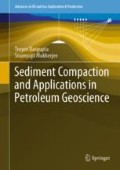Abstract
Overpressure situation can be created in both clastic and non-clastic reservoirs when at some depth the formation pressure exceeds what is expected for a hydrostatic (normal/lithostatic) pressure scenario. Likewise an underpressure situation has also been reported from reservoirs after sufficient hydrocarbons have been extracted. Over- and underpressure can develop by both tectonic (e.g., horizontal or vertical stress) and atectonic processes (e.g., mineral phase change, kerogen maturation). Presence or withdrawal of water (saline and freshwater) and hydrocarbon can produce over- and underpressure. Fracture pressure and its gradient are important in planning well-drilling programmes. Pore pressure estimation has become an active field of research in the present day oil industry and several methods exist for such estimation.
Access this chapter
Tax calculation will be finalised at checkout
Purchases are for personal use only
References
Bellotti P, Giacca D (1978) Pressure evaluation improves drilling performance. Oil Gas J
Biot MA (1941) General theory of three-dimensional consolidation. J Appl Phys 12:155164. https://doi.org/10.1063/1.1712886
Bowers GL (1995) Pore pressure estimation from velocity data; accounting for overpressure mechanisms besidesundercompaction. In: SPE drilling and completions, June
Bowers GL (1999) State of the art in pore pressure estimation. DEA-119 Report No 1
Bowers GL (2001) Determining an appropriate pore-pressure estimation strategy. In: Offshore technology conference 13042
Byerlee J (1993) Model for episodic flow of high-pressure water in fault zones before earthquakes. Geology 21:303–306
Dickinson G (1953) Geological aspects of abnormal reservoir pressures in Gulf Coast Louisiana. AAPG Bull 37:410–432
Donaldson EC, Chilingar GV, Robertson JO Jr, Serebryokov V (2002) Introduction to abnormally pressured formations. Developments of Petroleum Science, vol 50. Elsevier, Amsterdam, pp 1–19
Eaton BA (1972) The effect of overburden stress on geopressure prediction from well logs. J Pet Technol 24:929–934
Eaton BA (1975) The equation for geopressure prediction from well logs. In: Fall meeting of the society of petroleum engineers of AIME, Society of petroleum engineers
Engelder T (1993) Stress regimes in the lithosphere. Princeton University Press, Princeton
Fertl WH (1976) Abnormal formation pressures. Elsevier Scientific Publishing Co, New York, p 210
Foster JB, Whalen JE (1966) Estimation of formation pressures from electrical surveys Offshore Louisiana. J Petrol Technol 18(2):165–171
Gardner GHF, Gardner LW, Gregory AR (1974) Formation velocity and density—the diagnostic basis for stratigraphic traps. Geophysics 39:2085–2095
Ham HH (1966) A method of estimating formation pressures from Gulf Coast well logs. Gulf Coast Assoc Geol Soc Trans 16:185–197
Hart BS, Flemings PB, Deshpande A (1995) Porosity and pressure: role of compaction disequilibrium in the development of geopressures in a Gulf Coast Pleistocene basin. Geology 23:45–48
Hottman CE, Johnson RK (1965) Estimation of formation pressures from log-derived shale properties. J Pet Technol 17:717–722
Hunt JM (1990) Generation and migration of petroleum from abnormally pressured fluid compartments. AAPG Bull 74:1–12
Lane RA, Macpherson LA (1976) A review of geopressure evaluation from well logs-Louisiana Gulf Coast. J Petrol Technol 28(9):963–971
Law BE, Ulmishek GF, Slavin VI (1998) Abnormal pressures in hydrocarbon environments. In: Law BE, Ulmishek GF, SlavinVI (eds) Abnormal pressures in hydrocarbon environments. AAPG Memoir 70, pp 1–11
Louden LR (1972) Origin and maintenance of abnormal pressures. In: SPE 3843, 3rd symposium on abnormal subsurface pore pressure, Lousiana State University
Matthews WR, Kelly J (1967) How to predict formation pressure and fracture gradient from electric and sonic logs. Oil Gas J 20:92–106
Mukherjee S (2011) Estimating the viscosity of rock bodies-a comparison between the Hormuz-and the Namakdan Salt Domes in the Persian Gulf, and the Tso Morari Gneiss Dome in the Himalaya. J Indian Geophys Union 15:161–170
Mukherjee S, Kumar N (2018) A first-order model for temperature rise for uniform and differential compression of sediments in basins. Int J Earth Sci 107:2999–3004
Mukherjee S, Talbot CJ, Koyi HA (2010) Viscosity estimates of salt in the Hormuz and Namakdan salt diapirs, Persian Gulf. Geol Mag 147:497–507
Osborne MJ, Swarbrick RE (1997) Mechanisms for generating overpressure in sedimentary basins: a revaluation. Am Assoc Pet Geol 81:1023–1041
Owolabi OO, Okpobiri GA, Obomanu IA (1990) Prediction of abnormal pressures in the Niger Delta Basin using well logs. Paper No CIM/SPE 90-75
Pennebaker ES (1968) An engineering interpretation of seismic data. In: Fall meeting of the society of petroleum engineers of AIME. Society of Petroleum Engineers
Powers MC (1967) Fluid-release mechanism in compacting marine mud-rocks and their importance in oil exploration. AAPG Bull 51:1240–1245
Swarbrick RE, Osborne MJ (1998) Mechanisms that generate abnormal pressures: an overview. In: Law BE, Ulmishek GF, Slavin VI (eds) Abnormal pressures in hydrocarbon environments: AAPG Memoir 70, pp 13–34
Swarbrick RE, Osborne MJ, Yardley GS (2002) Comparison of overpressure magnitude resulting from the main generating mechanisms. In: Huffman AR, Bowers GL (eds) Pressure regimes in sedimentary basins and their prediction. AAPG Memoir 76, pp 1–12
Terzaghi K, Peck RB, Mesri G (1996) Soil mechanics in engineering practice, 3rd edn. Wiley, Hoboken
Traugott M (1997) Pore/fracture pressure determinations in deep water. Deepwater technology, supplement to August. World Oil 218, pp 68–70
Zhang J (2011) Pore pressure prediction from well logs: methods, modifications, and new approaches. Earth-Sci Rev 108:50–63
Author information
Authors and Affiliations
Corresponding author
Rights and permissions
Copyright information
© 2020 Springer Nature Switzerland AG
About this chapter
Cite this chapter
Dasgupta, T., Mukherjee, S. (2020). Pore Pressure Determination Methods. In: Sediment Compaction and Applications in Petroleum Geoscience. Advances in Oil and Gas Exploration & Production. Springer, Cham. https://doi.org/10.1007/978-3-030-13442-6_3
Download citation
DOI: https://doi.org/10.1007/978-3-030-13442-6_3
Published:
Publisher Name: Springer, Cham
Print ISBN: 978-3-030-13441-9
Online ISBN: 978-3-030-13442-6
eBook Packages: Earth and Environmental ScienceEarth and Environmental Science (R0)

